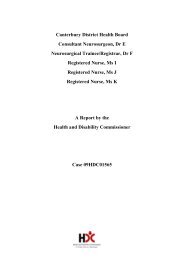Gisborne Hospital Report - Health and Disability Commissioner
Gisborne Hospital Report - Health and Disability Commissioner
Gisborne Hospital Report - Health and Disability Commissioner
You also want an ePaper? Increase the reach of your titles
YUMPU automatically turns print PDFs into web optimized ePapers that Google loves.
<strong>Gisborne</strong> <strong>Hospital</strong> 1999 – 2000<br />
Incident <strong>Report</strong>ing <strong>and</strong> Complaints Procedure<br />
3.12 The policy states that the outcomes of incident reviews are not reported back<br />
to the reporter in all cases but they are available (statement 13). No detail is<br />
given of where they are available from <strong>and</strong> who can access them.<br />
3.13 The incident reporting flowchart requires staff to determine whether<br />
immediate notification of the appropriate staff member/manager is required.<br />
No detail is given to assist staff to determine which incidents require<br />
immediate notification (step 3).<br />
3.14 The Incident <strong>and</strong> Complaint Management Policy lists a range of monthly <strong>and</strong><br />
quarterly reports that will be made to the Q&RMC, Core Quality Group<br />
(CQG) <strong>and</strong> the Audit Committee. The CQG (which is the most senior quality<br />
group of the organisation) is to receive a monthly summarised report of<br />
complaints but not of incidents. Incidents are reported to the Q&RMC. The<br />
policy provides no direction on the dissemination of report findings to staff.<br />
3.15 Minutes of the CQG meeting of 16 August 1999 stated that there was still a<br />
need to define “incident” <strong>and</strong> to clarify what needs to be reviewed <strong>and</strong> what<br />
needs to be cumulatively reported. The revised Incident <strong>and</strong> Complaint<br />
Management Policy was approved on 6 March 2000. The last two of these<br />
requirements were not addressed in the newly approved policy <strong>and</strong> remain<br />
outst<strong>and</strong>ing.<br />
4. PRACTICAL ISSUES RELATED TO INCIDENT REPORTING<br />
Practical matters<br />
4.1 A review of the documents, <strong>and</strong> discussions with staff, highlighted a number<br />
of practical issues.<br />
4.2 Categories have been introduced on the review form - for example, cultural<br />
distress <strong>and</strong> contractor complaints - with no guidance as to their meaning. In<br />
the absence of clear guidelines there may be inconsistent trend reports.<br />
4.3 Incident forms are not printed with a number <strong>and</strong>, as a result, tracking can be<br />
difficult. Both copies of the incident form are easily detachable <strong>and</strong> may<br />
become separated en route to the Quality Co-ordinator’s office. The Quality<br />
Co-ordinator commented that there is currently no mechanism to track filed<br />
incident report forms <strong>and</strong> it cannot be guaranteed that they all arrive in her<br />
office. An example of this is the initial incident form (October 1999)<br />
regarding Dr Lucas’ reuse of syringes which was witnessed as being<br />
completed <strong>and</strong> h<strong>and</strong>ed in to the Theatre Manager. However, the report was<br />
never entered into the system <strong>and</strong> the Quality Co-ordinator had no record of<br />
having received it.<br />
4.4 The length of time between the completion of an incident form <strong>and</strong> review by<br />
the reviewer was also identified as an issue in relation to the reuse of syringes.<br />
The November 1999 incident form relating to Dr Lucas took three weeks to go<br />
from the clinical area to the Quality Co-ordinator <strong>and</strong> then to the reviewer,<br />
during which time additional risk could have been prevented.<br />
50
















